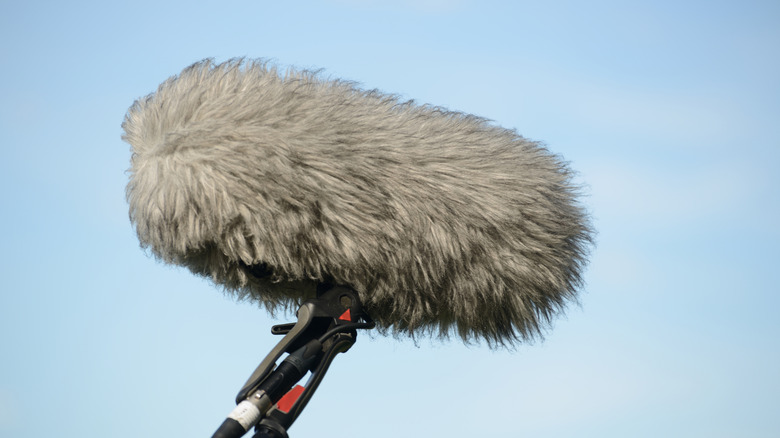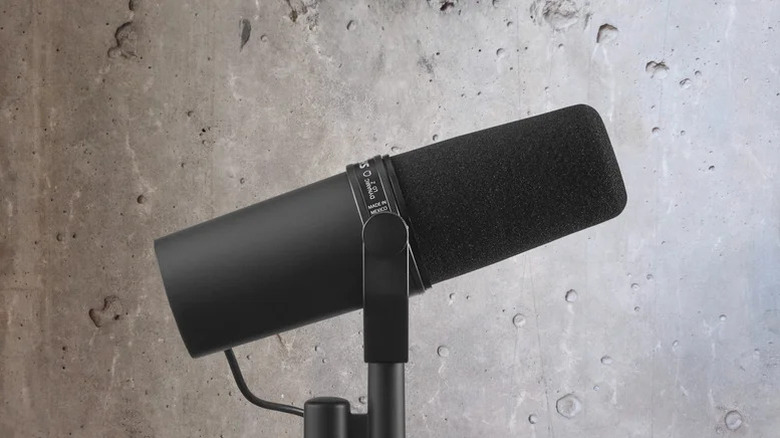Why Do Some Microphones Have Fuzzy Covers?
If you're the type who watches behind-the-scenes videos of film sets, you may have noticed that some microphones mounted on cameras or booms come clad in a fuzzy cover. It resembles nothing so much as a shaggy pelt of the kind that might bring to mind mammals adapted to cold climates. Or maybe you've noticed that, from concert stages and talk shows to press conferences and podcasts, vocal microphones are covered in fuzzy, foam covers that appear to be made of a material similar to what you'd find in a cheap cushion. For the uninitiated, these covers can seem strange, leading some to wonder what on earth they could be for.
To understand the fuzzy covers, whether they're furry or foamy, you first need to understand some of the ways microphones react to the environment around them. The types of microphones used professionally are much more sensitive than those found on, say, the latest smartphones or Bluetooth earbuds. This allows them to excel at capturing the nuances of the sonic environment around them, but that same sensitivity makes them susceptible to all kinds of interference. Microphone covers and screens made of fuzzy materials are one way to help alleviate unwanted sounds in recordings. Below, we'll break down the two primary kinds of fuzzy microphone covers and their respective purposes.
The shaggy covers you see on film sets are wind muffs
The shaggy, fur-like cover you'll see on boom mics for big productions like movies and TV, that's called a wind muff or wind screen, sometimes also called a windjammer, and its job is to prevent the microphone from picking up wind noise. The professional microphones used on sets are incredibly sensitive to even the smallest noises. That sensitivity is useful for picking up an actor whose dialogue is delivered in a whisper or low voice, or for even more subtle sounds. Outdoors, even a gentle breeze can ruin an otherwise great dialogue shot by picking up noise in the microphone, so the wind muff helps to prevent that pickup while keeping everything else clear. They're sometimes used indoors, too, since something as simple as ventilation fans or someone opening a door can create enough air movement to ruin a recording. And, as video content creation grows more popular, you'll even see wind muffs on some of the best mobile microphones.
Okay, blocking air noise makes sense, but why do wind muffs need to be fuzzy? The answer is that they're designed to mimic fur. The shagginess of the wind cover directs moving air around the microphone rather than into it, but sounds such as dialogue will not be interfered with. In fact, the fur-like appearance of wind muffs has led to a rather macabre nickname. People working on film sets often call them "dead cats." You'll even see some of these sorts of windshields sold under that nickname. But don't worry, the material is completely synthetic, and no animals were harmed.
Foam covers and other accessories are pop screens
There are other covers for microphones that, while not as fuzzy as a wind muff, are still soft enough to earn that adjective. Usually, these are made of foam and are typically seen on broadcast microphones. Some of the best vocal microphones for home studios and podcasting, like the evergreen Shure SM7B, even come with them preinstalled. These are also wind screens, but they also function as pop filters. Their job is to prevent the microphone from being overloaded by small blasts of air that happen when someone is speaking or singing close to a microphone.
Those small air blasts are called plosives, and they happen when we use severe consonants like "p," "b," or "t." You can test this yourself by holding your palm up to your mouth, then clearly enunciating a word like "spit" or "break." You'll notice that extra air comes out of your mouth when you pronounce the plosives in those words. That burst of air overwhelms the microphone's diaphragm (the component that vibrates to pick up the squiggly air we call sound), causing the recording to sound harsh and distorted. The pop filter disperses moving air from a plosive burst, reducing its impact on the diaphragm.
Pop filters in settings like recording studios often do not look like the fuzzy covers you see on broadcast microphones. Instead, they are flat, circular discs with mesh or woven nylon stretched across their circumference. In a setting like a vocal booth where air is only coming from the vocalist's mouth, there's no need to have a pop filter that protects the entire mic head, so discrete pop filters help preserve the microphone's character and room sound.


